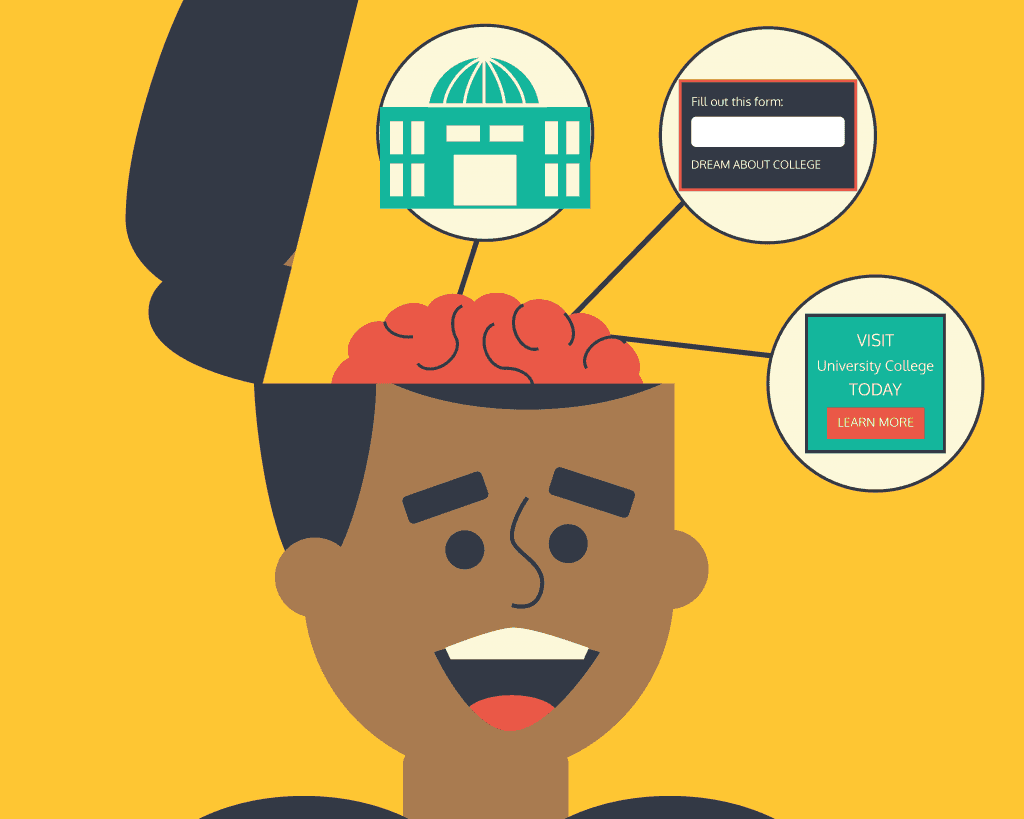The Sales Cycle That Never Ends: Getting the Best Marketing Return for Higher Education (Part 1)

Did you know that a shark can detect a fish’s heartbeat before it attacks? Or that cheese is the most stolen food in the world? (Thanks for those dinner party facts, Google.) With massive amounts of information available at the swipe of a screen, we’re constantly processing new information. Whether that information is necessarily relevant to your everyday life or not is another story.
Besides looking up shark facts, prospective students are also using their access to information to search for colleges–and they’re starting those searches early. And because students are starting education research early, the sales cycle for colleges and universities is growing.
What’s the education sales cycle?
The length of time between when a student first begins looking at schools and when the student actually attends could be 2 years or more. This poses a problem for education marketers. If a student sees ads for a school two years before they actually choose to attend, it may be hard to trace how past marketing efforts are affecting current enrollment.
The formula for attracting students through digital advertising isn’t as simple as spending a certain dollar amount on AdWords and watching the applications flow in immediately. Different strategies are needed for each phase in the sales funnel. In this post, I’ll outline what the first step of the education sales funnel is–and how to best approach it.
What you need to know about the early stages of the funnel
In those early stages of education research, prospective students are looking for general information, according to the all-knowing search engine, Google. Initial searches are more general than searches later in the cycle.
General searches use broad keywords and shorter phrasing, like “best value university,” “engineering programs,” or “art schools in the Midwest.” These searches indicate openness; the prospective students want to see what is available to them. More specific, often branded, searches will happen later, like “javascript coding class in Brooklyn area,” or “Harvard University English courses.”
Plus, did you know that nine in ten prospective students start their searches not knowing which school they’ll attend? This is great news for education marketers because prospective students begin with open minds.
So how do you incorporate these findings into digital advertising? Since the beginning of the sales funnel is all about keeping it general, digital marketing efforts should also keep it general, too.
How to first approach digital marketing for higher education
First and foremost, ads should encourage students to visit the website and sign up for more information. Then, it’s always helpful to then direct them to a landing page that encourages other types of conversions, like watching a video, signing up for a newsletter, and so on.
Like Doug suggested, at this phase, treat PPC as a lead generation source. This early research presents the opportunity to start collecting details about prospective students, which then allows you to more effectively market to them later on in the sales cycle.
The initial advertising efforts will focus on smaller conversions, like getting an email address or filling out a contact form. Once a prospective student has filled out a contact form, advertising can then be tailored more specifically towards their needs.
For example, if a student is still a sophomore in high school, they don’t need to be targeted ads about signing up for classes yet. However, they may be interested in receiving email updates or watching fun videos about life at the University of XYZ so they can begin daydreaming about how amazing college will be.
Tracking is important at every stage of the funnel
As an education marketer who excels at showing students how amazing your college or university or class is, your fantastic ideas may sometimes outshine your budget. We can help with that. To be sure you’re getting the best return from your marketing budget, keep this word in mind: tracking, tracking, tracking.
Data about conversions and interactions with your website and ads will help you determine if your marketing efforts are working and where you need to adjust. (If you’re an education marketer who’s fed up with your current agency’s reporting or lack thereof, contact us–we’re pretty proud of our extensive reports.)
Glad you’re studying up on the education sales funnel
Don’t worry. The lengthening sales cycle isn’t all bad news for education marketers. It gives universities and colleges time to show off their programs and current students through stories, videos, and, of course, ads.
All of these tools can shape the prospective student’s journey through the website and eventually to the application. Remember that in the beginning, prospective students are open-minded and want to learn about how spectacular your education institution is, so show them that through your advertising efforts! Then you’ll be ready for the next step of the conversion funnel.
—
What’s your favorite obscure dinner party fact? Any tips for the beginning of the education sales cycle? Tweet us at @Perfect_Search.

Rachel originates from Kansas City, Missouri (go Royals!). She grew up riding her horse Tinkerbelle and she has a secret knack for making really authentic puppy noises. Two of her greatest wishes? Driving a Tesla and becoming fluent in Russian.
